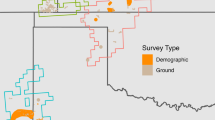Summary
Methods for assessing mixtures and their dynamic interaction over time are proposed, based on response functions relating biomass yield of each species to the densities of the component species. This approach allows a number of different facets of mixtures to be studied in a common framework. Two examples are given. Substitution rates between species and perceived densities for individuals in mixture are defined. These measure the impact of their environment on individuals. The relative resource total (RRT), is suggested as an index of whether species are capturing the same resource amount in mixture as in pure stand. Two indices of the comparative performance of species over time are proposed. The two examples, one with cattle and sheep and the other a plant mixture diallel with 6 genotypes illustrate the use of the methods. In the animal example the maximum yield mixture was calculated, the species perceptions of each other assessed and it is shown that mixing increased the resource capture by up to 17%. In general, the smaller species performed relatively better in mixture over the experimental period. In the plant example, individual plant size varied considerably over genotypes and this was reflected in their perceptions of each other, but not in their pure stand or mixed crop yield potential. Most genotype pairs showed antagonistic behaviour, whether measured by crop yield potential or by the index of resource capture. These conclusions are contrasted with those from an analysis of the data using substitutive methods.
Similar content being viewed by others
References
Blackman VH (1919) The compound interest law and plant growth. Annals of Botany. XXXIII. No CXXXI, 353–360
Connolly J (1980) Some experimental and statistical methods and problems in competition studies. Proc Workshop on Mixed Grazing, Galway, p 164–180. Published by An Foras Taluntais, 19 Sandymout Ave, Dublin 4, Ireland
Connolly J (1986a) On difficulties with replacement series methodology in mixture experiments. J Appl Ecol 23:125–137
Connolly J (1986b) Importance and measurement of mixture effects in grazing systems. In: Gudmundsson O (ed) Proc Grazing research at northern latitudes. Plenum Press, 323–333
Connolly J, Nolan T (1976) Design and analysis of mixed grazing experiments. Anim Prod 23:63–71
Donald CM (1963) Competition among crop and pasture plants. Adv in Agron 15:1–118
Firbank LG, Watkinson AR (1985) On the analysis of competition within two-species mixtures of plants. J Appl Ecol 22:503–517
Huxley PA, Maingu Z (1978) Use of a systematic spacing design as an aid to the study of intercropping: Some general considerations. Expl Agric 14:49–56
Inouye RS, Schaffer WM (1981) On the ecological meaning of ratio (de Wit) diagrams in plant ecology. Ecology 62(6):1679–1681
Joliffe PA, Minjas AN, Runeckles VC (1984) A reinterpretation of yield relationships in replacement series experiments. J Appl Ecol 21:227–243
Maynard Smith J (1974) Models in ecology. Cambridge University Press, pp 146
Mead R, Willey RW (1980) The concept of a ‘Land Equivalent Ratio’ and advantage in yields from intercropping. Expl Agric 16:217–228
Milthorpe FL (1961) The nature and analysis of competition between plants of different species. In: Milthorpe FL (ed) Mechanisms in biological competition. Soc Exp Biol 15:330–355
Nelder JA, Wedderburn RWM (1972) Generalised linear models. JRSS (A) 135:370–384
Norrington-Davies J, Hutto JM (1972) Diallel analysis of competition between diploid and tetraploid genotypes of Secale cereale grown at two densities. J Agric Sci Camb 78:251–256
Nunney L (1980) Density compensation, isocline shape and single level competition models. J Theor Biol 86:323–349
Spitters CJT (1983a) An alternative approach to the analysis of mixed cropping experiments. 1. Estimation of competition effects. Neth J Agric Sci 31:1–11
Spitters CJT (1983b) An alternative approach to the analysis of mixed cropping experiments. 2. Marketable yield. Neth J Agric Sci 31:143–155
Suehiro K, Ogawa H (1980) Competition between two annual herbs, Atriplex gmelini CA Mey and Chenopodium album L, in mixed cultures irrigated with seawater of various concentrations. Oecologia (Berlin) 45:167–177
Trenbath BR (1978) Models and interpretation of mixture experiments. Plant Relations Past, 145–162
Wit CT, de Van den Bergh JP (1965) Competition between herbage plants. Neth J Agric Sci 13:212–221
Wright AJ (1981) The analysis of yield-density relationships in binary mixtures using inverse polynomials. J Agric Sci Camb 96:561–567
Author information
Authors and Affiliations
Rights and permissions
About this article
Cite this article
Connolly, J. On the use of response models in mixture experiments. Oecologia 72, 95–103 (1987). https://doi.org/10.1007/BF00385051
Received:
Issue Date:
DOI: https://doi.org/10.1007/BF00385051




